
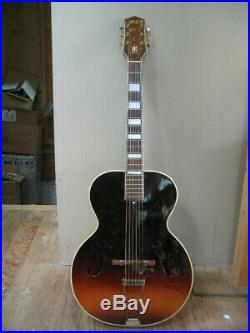
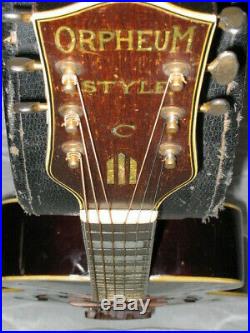
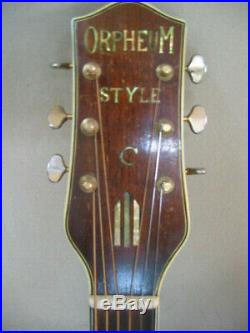
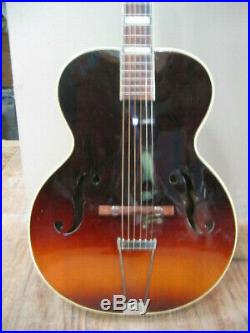
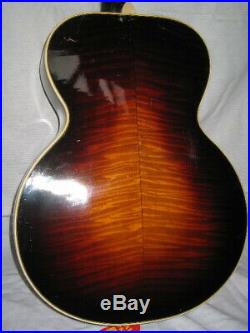
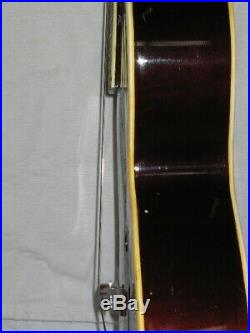
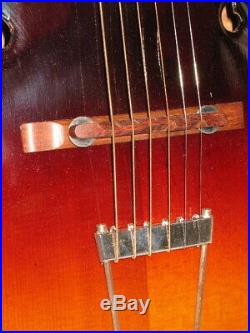
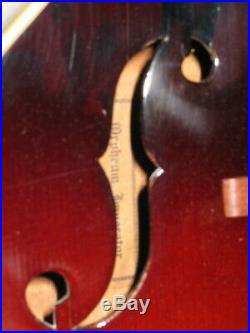
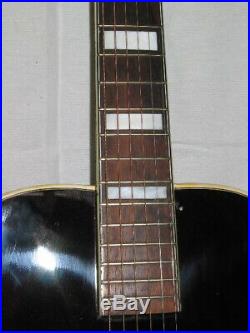
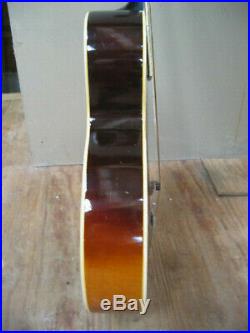

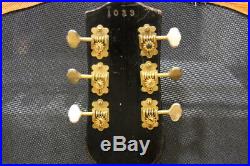

A strikingly authentic archtop. The lable reads Orpheum Imperator, Style C. Serial# 1033 (C and serial number are handwritten in ink). Similar in some ways to early 30s model labeled Imperator, which, in Latin, references the Epiphone Emperor. Book matched flame maple back. 3 ply binding on the top. 3 ply binding on the back. 3 ply binding on the neck / fretboard. Comfortable mahogany neck; not too thick or’clubby’. Back of headstock is stamped 1033 Orpheum C in pearl inlaid on the headstock. 6 individual inlays on the fretboard (Eddy Lang L-5 style large, all pearl). These are the more sought after, full-block inlays. Rose fretboard with thin nickel frets, dressed by Otto D’Ambrosio, Formerly Monteleone and Mandolin Bros. Now director of the Eastman Custom Shop. Bone nut ivaroid heel cap. Unbound, segmented F holes, like the early L-5s and D’Angelicos. Rose adjustable bridge with brass wheel adjusters. Can’t really date this except mid 1930’s. Period catalogue showed the models A, B and C with C being the top model. While playable, and good for pumping out acoustic chords in a big band or recording setting, it would benefit from a neck reset. Worth the effort; it has all the right materials and craftsmanship. Orpheus was a legendary Greek musician, poet and prophet. “Imperator is Latin for “Emperor. The Orpheum Imperator is a premium quality prewar American archtop guitar of unusual rarity. And there you have it. The Orpheum brand was introduced in 1908 for the ornate banjos built by Rettberg and Lange in New York City, who also produced the celebrated Paramount line. The first guitars bearing the Orpheum name debuted in 1933, and were built by the custom shop at Regal in Chicago for the Manhattan wholesaler Harry Stadlmair & Co. Inspired by the Gibson L-5, the Model C was Orpheum’s top-of-the-line 16 guitar, and like its counterpart was carved of all solid tonewoods, and fitted with premium gold hardware. With sales sharply limited by the Great Depression however, only a few of these upscale models were produced, and fewer still survive to this day. Indeed, this is the only example of this model we have seen apart from catalog engravings. The resemblance to the Loar-era L-5 is more than coincidental (‘everybody’ copied them). The fine grained spruce soundboard is carved to exceptionally fine tolerances, with graceful narrow Cremona style soundholes. The back and sides are carved of particularly intense highly figured solid fiddleback maple, and the multi-bound body is finished in a lustrous spirit varnish, like Gibsons of the 20’s. The gold Grover G-98 tuners and wrap-around tailpiece are identical to those used on the 16 L-5 as well. And of special note is the unique finish pattern, a horizontal sunburst spanning the entire lower bout of the soundboard, and masterfully shaded. The Orpheum Model C embodies both Gibson (block inlays) and Epiphone (rose fingerboard) features. While similar to the Loar L-5 in many respects, the Model C incorporates features seen only in Gibson’s later models. The soundboard is X-braced for greater sustain and warmth, as featured on Gibson’s 17 Advanced Model guitars of the mid-to-late 30’s. The longer 25 1/2 scale increases projection and punch, and is not seen on the L-5 until just before WWII. And most remarkably, the neck of the Model C is mahogany, with a light Bra rose fingerboard inlaid with solid pearl. At a mere 4lb. In weight, the instrument is feather light, highly responsive, and notably well balanced. This rare example has all-original finish and hardware. The segmented soundholes are an echo of the early Epiphone Masterbilt archtops, and the neck has a C profile. Playwear is moderate; there is finish wear on the back of the neck; its thumbwear is a clue to its well played-in tone. The voice is particularly clear and open, with notable transparency, brilliance and detail: a vibrant acoustic archtop of the Golden Era. A unique and finely crafted instrument, the Orpheum Imperator Model C is a remarkable discovery, from a nearly forgotten chapter of fine American luthiery. The item “Rare 90 yr old Orpheum Imperator Style C Carved Vintage Archtop Guitar” is in sale since Thursday, March 14, 2019. This item is in the category “Musical Instruments & Gear\Vintage Musical Instruments\Vintage Guitars & Basses\Acoustic Guitars”. The seller is “macmidi8hw5″ and is located in Boston, Massachusetts. This item can be shipped to United States.


